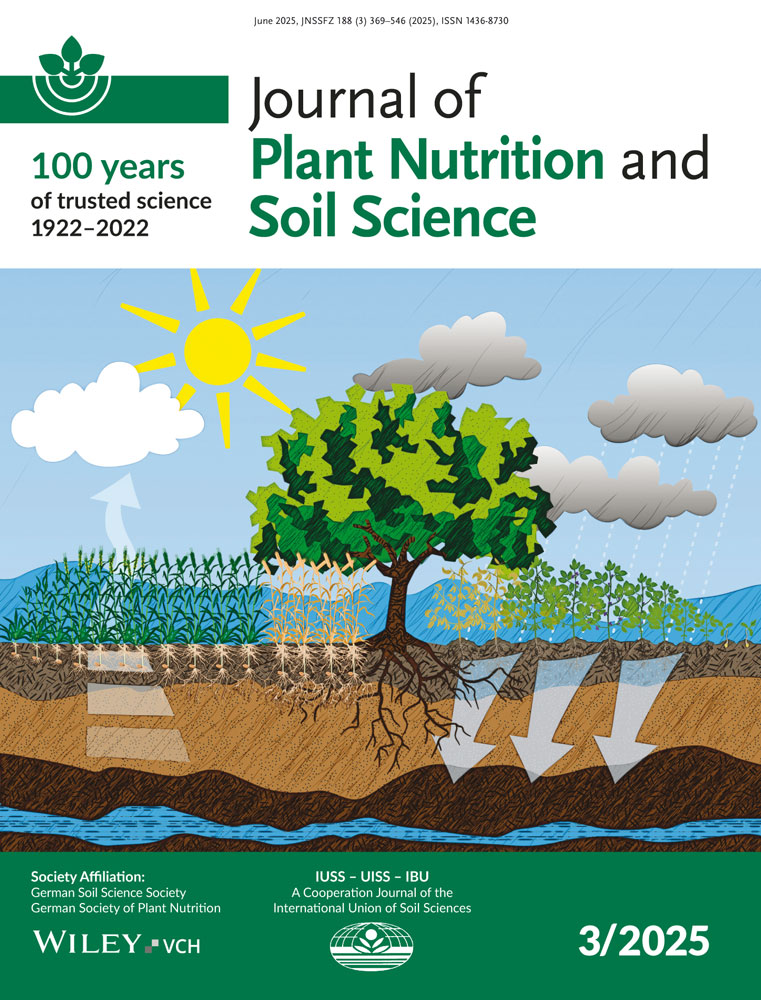The role of potassium in alleviating detrimental effects of abiotic stresses in plants†
This paper was presented at the “International Potash Institute (IPI) Golden Jubilee Congress 1952–2002” held at Basel, October 8–10, 2002 and published in the corresponding Proceedings of the IPI in 2003 entitled “Feed the soil to feed the people: the role of potash in sustainable agriculture”.
Abstract
enPlants exposed to environmental stress factors, such as drought, chilling, high light intensity, heat, and nutrient limitations, suffer from oxidative damage catalyzed by reactive oxygen species (ROS), e.g., superoxide radical (O2equation/tex2gif-sup-1.gif–), hydrogen peroxide (H2O2) and hydroxyl radical (OHequation/tex2gif-sup-4.gif). Reactive O2 species are known to be primarily responsible for impairment of cellular function and growth depression under stress conditions. In plants, ROS are predominantly produced during the photosynthetic electron transport and activation of membrane-bound NAD(P)H oxidases. Increasing evidence suggests that improvement of potassium (K)-nutritional status of plants can greatly lower the ROS production by reducing activity of NAD(P)H oxidases and maintaining photosynthetic electron transport. Potassium deficiency causes severe reduction in photosynthetic CO2 fixation and impairment in partitioning and utilization of photosynthates. Such disturbances result in excess of photosynthetically produced electrons and thus stimulation of ROS production by intensified transfer of electrons to O2. Recently, it was shown that there is an impressive increase in capacity of bean root cells to oxidize NADPH when exposed to K deficiency. An increase in NADPH oxidation was up to 8-fold higher in plants with low K supply than in K-sufficient plants. Accordingly, K deficiency also caused an increase in NADPH-dependent O2equation/tex2gif-sup-6.gif– generation in root cells. The results indicate that increases in ROS production during both photosynthetic electron transport and NADPH-oxidizing enzyme reactions may be involved in membrane damage and chlorophyll degradation in K-deficient plants. In good agreement with this suggestion, increases in severity of K deficiency were associated with enhanced activity of enzymes involved in detoxification of H2O2 (ascorbate peroxidase) and utilization of H2O2 in oxidative processes (guaiacol peroxidase). Moreover, K-deficient plants are highly light-sensitive and very rapidly become chlorotic and necrotic when exposed to high light intensity. In view of the fact that ROS production by photosynthetic electron transport and NADPH oxidases is especially high when plants are exposed to environmental stress conditions, it seems reasonable to suggest that the improvement of K-nutritional status of plants might be of great importance for the survival of crop plants under environmental stress conditions, such as drought, chilling, and high light intensity. Several examples are presented here emphasizing the roles of K in alleviating adverse effects of different abiotic stress factors on crop production.
Abstract
deDie Bedeutung von Kalium für die Verminderung der Schadwirkung abiotischer Stressfaktoren bei Pflanzen
Pflanzen, die in ihrer Umwelt Stressfaktoren wie Trockenheit, Kälte, hoher Lichtintensität, Hitze oder Nährstofflimitierung ausgesetzt sind, leiden unter oxidativer Schädigung durch reaktive Sauerstoff-Spezies (ROS), z. B. Superoxidradikal (O2equation/tex2gif-sup-11.gif–), Wasserstoffperoxid (H2O2) und Hydroxyl-Radikal (OHequation/tex2gif-sup-14.gif). Es ist bekannt, dass für die Beeinträchtigung zellulärer Funktionen und Wachstumsminderungen unter Stressbedingungen primär ROS verantwortlich sind. In Pflanzen werden ROS hauptsächlich beim photosynthetischen Elektronentransport und der Aktivierung von membrangebundenen NAD(P)H-Oxidasen gebildet. Es gibt zunehmend Hinweise, die vermuten lassen, dass eine Verbesserung des Kalium (K)-Versorgungszustandes der Pflanzen die ROS-Bildung durch eine Verminderung der Aktivitäten der NAD(P)H-Oxidasen und eine Aufrechterhaltung des photosynthetischen Elektronentransportes stark verringert. Kalium-Mangel verursacht eine starke Abnahme der photosynthetischen CO2-Fixierung und eine Beeinträchtigung der Verteilung und Nutzung von Photosynthaten. Solche Störungen führen zu einem Überschuss von bei der Photosynthese gebildeten Elektronen und dadurch zu einer Erhöhung der ROS-Bildung durch verstärkte Elektronenübertragung auf O2. Kürzlich wurde gezeigt, dass die Kapazität der Wurzelzellen von Bohne zur Oxidation von NAD(P)H unter K-Mangelbedingungen deutlich erhöht ist. Die NADPH-Oxidation war bei K-Mangel-Pflanzen im Vergleich zu ausreichend mit K versorgten Pflanzen um bis zu einem Faktor 8 erhöht. Entsprechend verursachte K-Mangel auch eine Zunahme der NADPH-abhängigen O2equation/tex2gif-sup-16.gif–-Bildung in Wurzelzellen. Diese Ergebnisse deuten an, dass die Zunahmen der ROS-Bildung bei dem photosynthetischen Elektronentransport und den Reaktionen NADPH-oxidierender Enzyme an der Membranschädigung und dem Chlorophyllabbau von K-Mangel-Pflanzen beteiligt sind. In guter Übereinstimmung mit dieser Vermutung war zunehmender K-Mangel mit erhöhter Aktivität von Enzymen verbunden, die an der Detoxifizierung von H2O2 (Ascorbat-Peroxidase) und am Verbrauch von H2O2 bei oxidativen Prozessen (Guaiacol-Peroxidase) beteiligt sind. Darüberhinaus sind K-Mangel-Pflanzen sehr lichtempfindlich und werden schnell chlorotisch und nekrotisch, wenn sie hohen Lichtintensitäten ausgesetzt werden. In Anbetracht dessen, dass die ROS-Bildung beim photosynthetischen Elektronentransport und durch NADPH-Oxidasen besonders hoch ist, wenn die Pflanzen Stressbedingungen in ihrer Umwelt ausgesetzt sind, scheint die Vermutung folgerichtig, dass eine Verbesserung des K-Versorgungszustandes von Pflanzen für deren Überleben bei ungünstigen Umweltbedingungen, wie Trockenheit, Kälte und hoher Lichtintensität, von großer Bedeutung ist. Es werden mehrere Beispiele gezeigt, welche die Rolle von K bei der Verminderung ungünstiger Auswirkungen von abiotischen Stressfaktoren auf die Pflanzenproduktion hervorheben.




